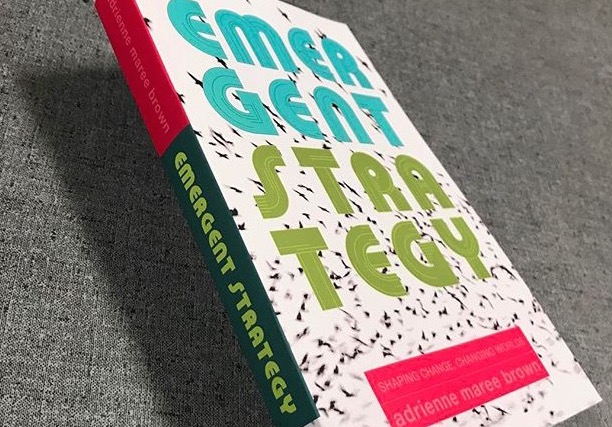You may know adrienne maree brown‘s work from the worlds of radical social justice, pleasure activism or writing. You may also remember brown from a conversation she had with Colorlines in the aftermath of the election about despair, hope and self-care in the Trump era. Since the publication of her latest book, "Emergent Strategy," brown has been offering insights and inspiration during countless moments of tragedy and crisis, based on the framework of her book.
This past week was no exception, when in the wake of the mass shooting in Las Vegas, she offered this on Facebook: "we are living in impossible times. if it were fiction it would be critiqued as hyperbolic. if it were nightmares we would never sleep. we are living in times created by our own species…our visions are ropes through the devastation. look further ahead, like our ancestors did, look further. extend, hold on, pull, evolve."
"Emergent Strategy" is a lyrical, explorative, non-linear journey of the book’s title, a concept she defines as "how we intentionally change in ways that grow our capacity to embody the just and liberated worlds we long for." She explains at the outset that the book is meant to be perused, returned to, and jumped around in more than once. There are essays, poems, exercises, dialogues, assessments, facilitations—even a playlist. It’s a book for people interested in radical social change, who are willing to think expansively about what the future could look like, or are in need of help doing that kind of thinking.
Octavia Butler books are brown’s bibles, and a range of activists and thinkers—including Angela Davis, Maya Angelou and Grace Lee Boggs—are her inspiration. As such, the footnotes are just as important to explore as the text itself, because they give entry into the work and people who have shaped brown’s world.
Here, a few distillations from the many lessons offered in the book, to whet your appetite for diving in and reading more.
1. Collaboration is the Cornerstone
"One of my favorite questions today is: How do we turn our collective full-bodied intelligence towards collaboration, if that is the way we will survive?" brown asks early on in the book, and it’s a theme that continues throughout. Nothing that she does, nor anything that she believes will change the world, happens without deep and radical collaboration. Throughout the book she cites natural examples of collaboration, including how birds travel in flocks, how ants build together and how fungi develop incredible growths throughout the earth.
"There is an art to flocking: staying separate enough not to crowd each other, aligned enough to maintain a shared direction, and cohesive enough to always move towards each other," she writes. These natural examples are essential to the idea of emergent strategy.
2. Embracing Change is a Non-Negotiable
"A first question to ask ourselves is, how do we practice increasing our ease with what is? Change happens. Change is definitely going to happen, no matter what we plan or expect or hope for or set in place. We will adapt to that change, or we will become irrelevant," she writes.
This is not a new idea, but rather a phenomenon that has led to countless reflections throughout time and culture. But brown somehow brings new insight to this age-old challenge, particularly through the insights she gathers from the world around her. The book states, "Emergent strategy is something I am still discovering, but a lot of it, for me, feels like tuning into the natural operating systems of the universe and being humbled, as opposed to trying to barrel through and against all the change, trying to best nature."
3. We Must Let Go of the Status Quo
Octavia Butler’s influence is throughout the book, and for good reason. Brown believes deeply in the power of science fiction to allow us to imagine the future planet’s needs, a future that may very well be divorced from current reality. "I would call our work to change the world ‘science fictional behavior’—being concerned with the way our actions and beliefs now, today, will shape the future, tomorrow, the next generations," she writes. The emphasis is not only in reading science fiction, and writing it, but also allowing it to shape the way we do and imagine social change work. "It is so important that we fight for the future, get into the game, get dirty, get experimental."
In many ways, this is what is so appealing about brown’s work—she is almost hopelessly optimistic. She refuses to give in to cynicism or despair, and this ability to dream wildly is part of why she can maintain such openness toward the idea of a better future. From her conclusion: "It is possible that this whole book is about love. My love of this planet, my love of human beings and creatures and the idea of there being a future in which this planet is still a home to living things. My love of the humans who have taught me to be awake and to feel the world around me, and clued me in to both caring more about life and being less attached to the outcomes of life."
